Navigate
Article List
- 2022 Asia Pacific Precious Metals Conference Summary
By Joni Teves, Precious Metals Strategist, UBS Investment Bank
- Regulatory Reforms In The Precious Stones & Precious Metals Dealers Sector
By Paramjit Singh, Registrar of Regulated Dealers, Director, Anti-Money Laundering/Countering the Financing of Terrorism Division (ACD), Ministry of Law
- ESG & Precious Metals Provenance: The Use Case For Digital Gold
By Jeffrey Premer, CEO, Vaultex
- Creating A Safe Haven For Generational Wealth
By Gregor Gregersen, Founder & Director, The Reserve
- Singapore – A Tokenised Gold Settlement Hub Built For The Future
By Anoushka Rayner, Head of Growth Commodities, Paxos
- China To Take Leading Role In Global Fuel Cell Electric Vehicle Market
By Trevor Raymond, Director of Research, World Platinum Investment Council (WPIC)
- Malaysia’s Gold & Gems Industry
By Ermin Siow, Advisor, Federation of Goldsmiths and Jewellers Association of Malaysia
- SBMA News
By SBMA
Article List
- 2022 Asia Pacific Precious Metals Conference Summary
By Joni Teves, Precious Metals Strategist, UBS Investment Bank
- Regulatory Reforms In The Precious Stones & Precious Metals Dealers Sector
By Paramjit Singh, Registrar of Regulated Dealers, Director, Anti-Money Laundering/Countering the Financing of Terrorism Division (ACD), Ministry of Law
- ESG & Precious Metals Provenance: The Use Case For Digital Gold
By Jeffrey Premer, CEO, Vaultex
- Creating A Safe Haven For Generational Wealth
By Gregor Gregersen, Founder & Director, The Reserve
- Singapore – A Tokenised Gold Settlement Hub Built For The Future
By Anoushka Rayner, Head of Growth Commodities, Paxos
- China To Take Leading Role In Global Fuel Cell Electric Vehicle Market
By Trevor Raymond, Director of Research, World Platinum Investment Council (WPIC)
- Malaysia’s Gold & Gems Industry
By Ermin Siow, Advisor, Federation of Goldsmiths and Jewellers Association of Malaysia
- SBMA News
By SBMA
2022 Asia Pacific Precious Metals Conference Summary
By Joni Teves, Precious Metals Strategist, UBS Investment Bank

JONI TEVES is the precious metals strategist within the UBS Economics and Strategy Research team, based in Singapore. She covers all four precious metals and is responsible for fundamental analysis, forecasting, and writing research pieces on these markets. She has been in the industry for 16 years, initially as a gold trader for the central bank of the Philippines, subsequently joining UBS as a precious metals strategist in 2011.
The focus of the 2022 APPMC was increasing accessibility and fungibility of precious metals, a fitting theme for the current environment, especially after the challenges and dislocations that the precious metals markets have faced in the past few years. The increasing role of gold and precious metals in investor portfolios highlights the importance of 24/7 market accessibility across various channels and more harmonised products.
It also raises the question of how gold and precious metals can evolve in the world of fintech and digital assets amid the shifting preferences of the next generation of market players and investors.
Singapore Bullion Market Association (SBMA) chairman KL Yap’s welcome address set out this theme clearly , providing the audience an overview of what to expect from the sessions for the rest of the conference. He was optimistic about the future growth in the region. One thing that stood out in his address was the initiative to have an Asian gold reference price, showing the discount or premium of kilo bars.

KL Yap, chairman of the Singapore Bullion Market Association, welcomed delegates to APPMC 2022.
The discussions and sessions during the rest of the conference could perhaps be summarised in three words: 1) unprecedented, 2) resilient and 3) optimistic. The first word is borrowed from the keynote speaker, Ong Sin Beng. The experience over the last couple of years was unprecedented as developments in the world have led to conditions that many people have not seen in their lifetime.
As an industry, we face numerous new challenges and uncertainties and therefore have had to adapt and figure out a way to navigate them. This is captured by the second word: resilient. Throughout the conference, participants engaged in many meetings to look for synergies and ways to work together and grow their businesses, which is a testament to the precious metals market’s resilience. A common theme among many presentations not only highlighted that the global pandemic caused a dip in GDP and a decline in sales and volumes, but more importantly, that these have all recovered from the lows in the aftermath. The market has seen dislocations, but it has endured.
The final word is optimistic, perhaps cautiously optimistic, given the continued uncertainty that we faced with the ongoing recovery from the pandemic and the lingering geopolitical fears but hopeful, nonetheless. Developments in bar provenance and integrity, responsible sourcing, sustainability and Environmental, Social and Governance (ESG) goals are all moving in the right direction. The continued dialogue around these topics allows us to look forward to the industry’s future. Technology can help us towards these developments and enable the industry to evolve into the digital world. Updates on the various ASEAN gold markets detailed some positive changes and increasing regulatory support, which should help the region to grow and develop.
Following the warm welcome from SBMA’s chairman, the conference kicked off with three special addresses. David Tait, global CEO of the World Gold Council (WGC), walked us through WGC’s regional initiatives and vision for the gold market.
Tait gave a detailed discussion on the WGC initiatives, such as the responsible gold mining principles and its collaboration with the LBMA to implement a global system of gold bar integrity, provenance, and chain of custody.
Tait gave a detailed discussion on the WGC initiatives, such as the responsible gold mining principles and its collaboration with the LBMA to implement a global system of gold bar integrity, provenance, and chain of custody. It tied in nicely with the next speaker, Sakhila Mirza, executive board director and general counsel, LBMA, who provided further details on this initiative, encouraging the audience to look forward to the results, which are to be released in Q3. She also summarised the LBMA’s 3-year strategic plan covering four key areas: 1) responsible sourcing, 2) physical market enhancements, 3) financial market enhancements, and 4) communications and engagement. One key takeaway from Mirza’s address was that the LBMA wants to get as much feedback on its strategy and initiatives and asks everyone to get more involved.
Moving on, Nicholas Frappell, ABC Refinery’s global head of institutional markets, emphasised the importance of information to increase accessibility. Investors need information to navigate these markets; this includes information on the market, macro factors, and education about product offerings. Their initiatives include providing retail customers regular updates via the refinery’s podcast, “The Pod of Gold”.
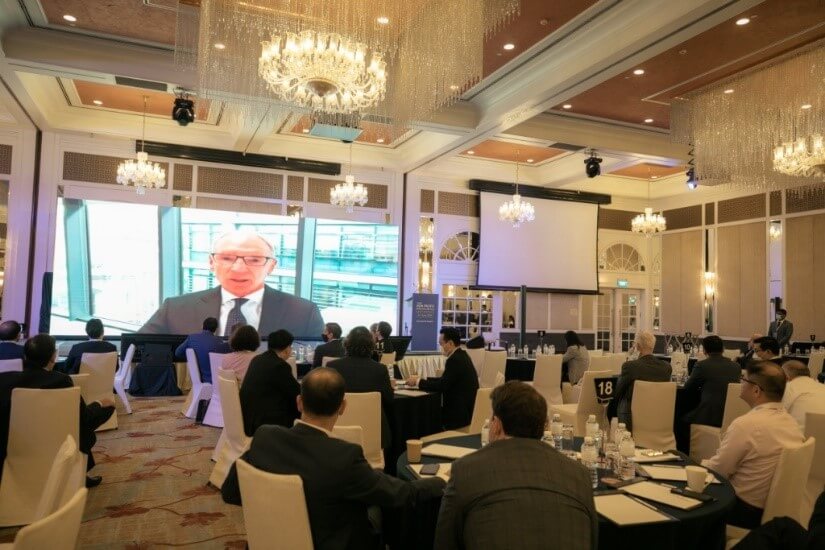
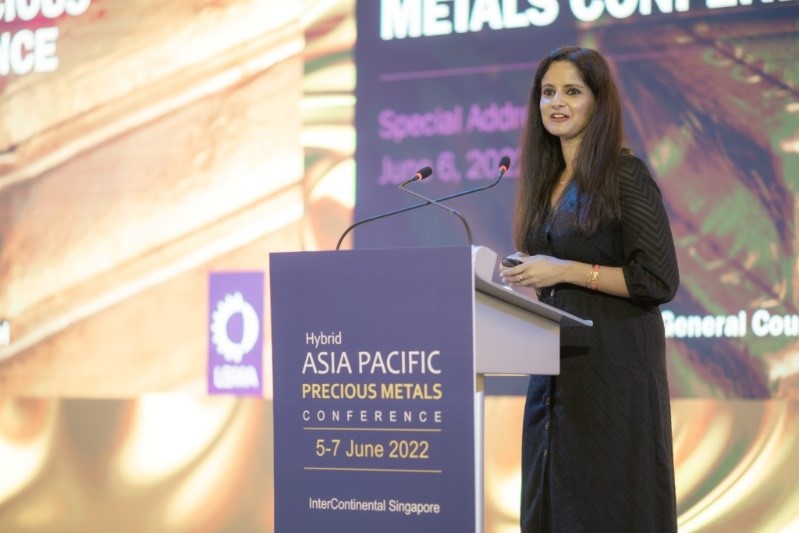
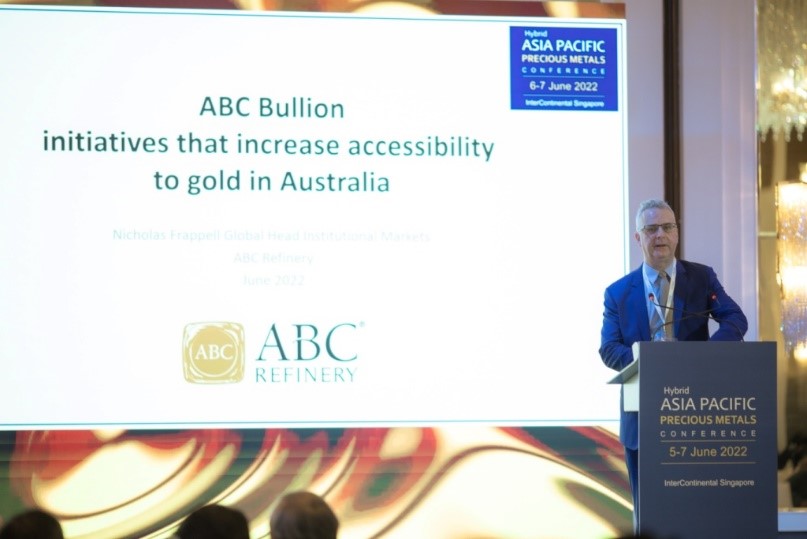
The keynote speech by Ong Sin Beng, chief economist for emerging Asia and ASEAN, JP Morgan Chase Bank, N.A., helped to contextualise the current macro backdrop, especially for the region. Among the key takeaways from the keynote speech is that firstly, EM Asia exports are likely to come down, which implies weaker Asian currencies versus the dollar. Second, inflation may ease, but there are risks to the upside. Inflationary pressures include high fuel costs, wage increases, rising input costs and the risk of physical commodity shortages. Based on their view, high inflation suggests that real rates should stay negative. The fear is that the world is already in a stagflationary environment – a scenario where growth is falling while inflation is high. There are also risks around the US Federal Reserve’s quantitative tightening.
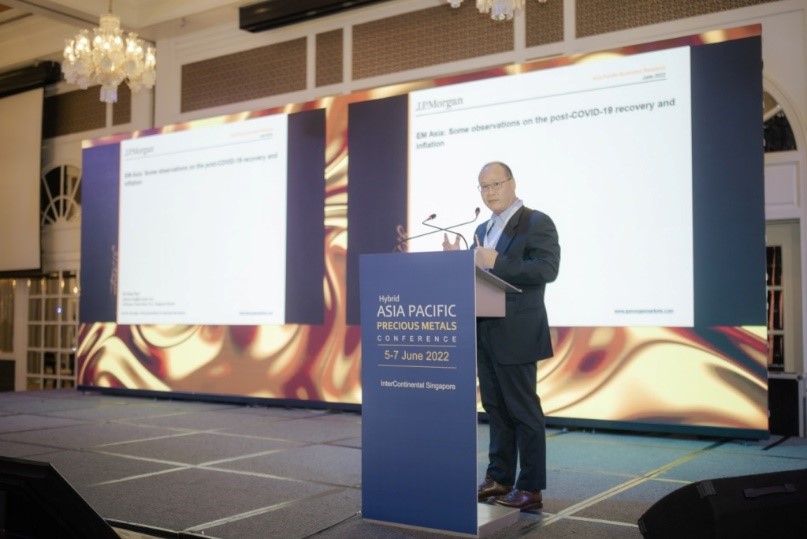
Moving to the first panel session, moderated by SBMA CEO Albert Cheng, it was interesting to hear about market updates across the region. Iskandar Simorangkir, deputy for macroeconomic and financial coordination under the government of Indonesia, brought the audience up to speed with recent and upcoming changes in the Indonesian gold market, such as the removal of the 10% VAT and the establishment of bullion banks to support the jewellery industry. Bullion banks are to sit at the core of market reform, which will be carried out gradually. Jennifer Heryanto, CEO of PT Sentral Kreasi Kencana (SKK Jewels) and one of Forbes’ “30 Under 30”, provided an update from the perspective of the Indonesian jewellery industry. Heryanto also provided details on recent regulatory changes in Indonesia, including the establishment of a national standard for gold content to help protect consumers, and two more regulations in the pipeline.
Huynh Trung Khanh, vice chairman of Vietnam Gold Traders Association (VGTA), then gave his insight on onshore premiums in Vietnam. It was interesting to hear about the strength in demand for Saigon Jewelry Company’s Dragon Tael Bars, which pushed premiums to as high as US$700 for an ounce of gold at one point. He also gave regulatory updates, including the liberalisation of production and sales of gold jewellery and 24 karat gold investment products, as well as easing and simplifying licensing conditions for gold tael bars in Vietnam.
REGULATION SEEMS TO BE MOVING IN THE RIGHT DIRECTION IN VIETNAM, BUT ONE TAKEAWAY FROM THE FOLLOWING SPEECH BY LE TRI THONG, CEO OF PHU NHUAN JEWELRY JV STOCK COMPANY, IS THAT THE PROCESS OF LIBERALISING SUPPLY MIGHT TAKE TIME.
Regulation seems to be moving in the right direction in Vietnam, but one takeaway from the following speech by Le Tri Thong, CEO of Phu Nhuan Jewelry JV Stock Company, is that the process of liberalising supply might take time. That said, engagement between the State Bank of Vietnam (SBV) and stakeholders such as the jewellery industry and the VGTA is overall quite positive.
For Thailand’s gold market, Tanarat Pasawongse, CEO of Hua Seng Heng, noted that one can trade gold domestically in US dollar terms, and that the Bank of Thailand allowed this to help contain the impact of net gold exports on the Thai baht. He also gave an overview of the Gold Now application, highlighting that the wide use of mobile banking in Thailand can create opportunities for the gold market.
To round up the panel session, Ermin Siow, advisor of the Federation of Goldsmiths and Jewellers Association, gave insight into the Malaysian gold market. Despite the decline in gold demand in Malaysia, he highlighted that companies’ bottom lines were less affected, helped by the high gold price and the resilience in underlying local demand to offset some of the losses in exports. Gold was the focus of the panel session, but it implied room for growth and the possibility of expansion into the PGMs and the rest of the precious metals within the region.

The afternoon session then kicked off with the launch of GoldZip by Brian Fung, CEO of the Chinese Gold & Silver Exchange Society (CGSE) and YK Goh, CEO of V Systems. It was interesting to get details of this digital gold token backed by GoldZip Eligible Gold Bars, the first physical gold-backed token issued by an exchange-related issuer.
The second panel session, led by John Levin, APAC head of commodities, TD Securities, focused on strategies to increase precious metals accessibility. Bruce Ikimezu, executive director of Japan Bullion Market Association (JBMA), spoke about the Zipang coin, a digital currency launched in Japan. It is still in its early stages and volumes are still limited. There are further developments in the pipeline, including launching similar products for other commodities, he said.
ANDREW NAYLOR, REGIONAL CEO, APAC (EX-CHINA), WGC, THEN FOCUSED ON THE DEMAND SIDE OF ACCESSIBILITY AND SPOKE ABOUT WHAT DRIVES CONSUMER INTEREST.
Andrew Naylor, regional CEO, APAC (ex-China), WGC, then focused on the demand side of accessibility and spoke about what drives consumer interest. Different sources and motivations for gold demand make gold a unique asset. He also noted that ESG issues are key factors in making gold more accessible, particularly for institutional investors, Naylor said.
Kazuya Naoki, head of metals, Asia of ICBC Standard Bank Plc., Singapore Branch focused on access to the physical market. Interestingly, his presentation showed the conditions in the physical market before and after COVID. The impact of the pandemic included: 1) disruptions to logistics , particularly the cost and time of moving metal physically, 2) dislocations leading to large swings in physical premiums, and 3) less leverage and more regional markets, caused by restrictions from COVID-related policies. The topic of accessibility in platinum group metals (PGMs) was then expertly tackled by Oliver Martin, PGM trader, AngloAmerican Platinum, who provided a long history of access to the PGM markets, dating back to the 1950s and 1960s. He summarised the evolution of players that had access to PGMs over time and highlighted the importance of introducing exchange-traded funds (ETFs) to allow more market participants to be involved.
All in all, the audience learned from this panel session that accessibility could mean anything from getting access to new products like the Zipang coin in Japan, addressing what consumers are looking for, such as ESG increasingly becoming a key consideration for many institutional investors, and access to physical markets in gold, silver and PGMs.
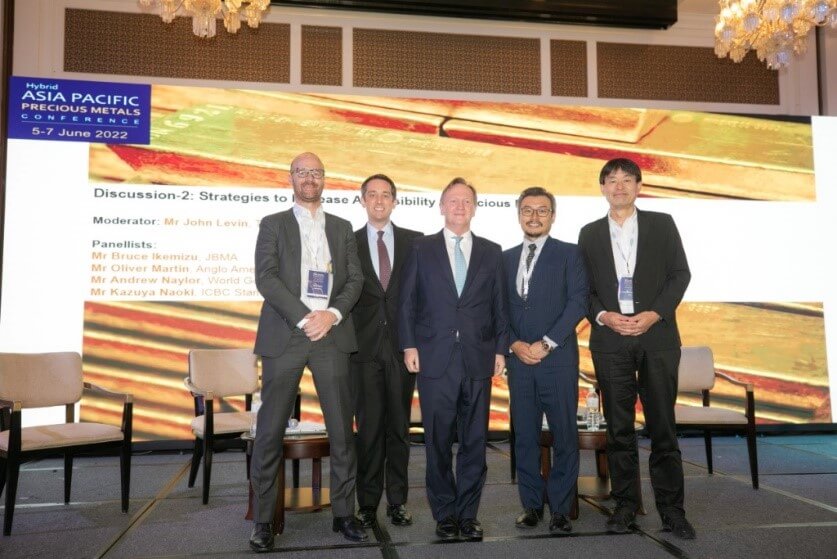
The third-panel session for the day, moderated by Sunil Kashyap, director of FINMET, focused on linking regional and international metals markets. Mirza provided the LBMA’s view, elaborating on the importance of having a common set of global standards, which could later be augmented to fit the regional context. Sachin Patel, senior director of metal products at CME Group, provided the perspective and insights from the CME, particularly into the unprecedented exchange for physical (EFPs) moves in 2020. Pramod Mohan, managing director of FINMET, then discussed the UAE gold market and the recent establishment of a UAE good delivery, currently with two refineries and more to come. To round up the panel, Ravi Ramakrishnan, head of precious metals trading Asia, JP Morgan, highlighted how the lack of fungibility in the gold market makes gold more of a commodity than a currency. He noted that varied demand drivers account for the key differences across the different markets. While it remains unclear how precious metals can be more fungible, it is important that the market is having the conversation.
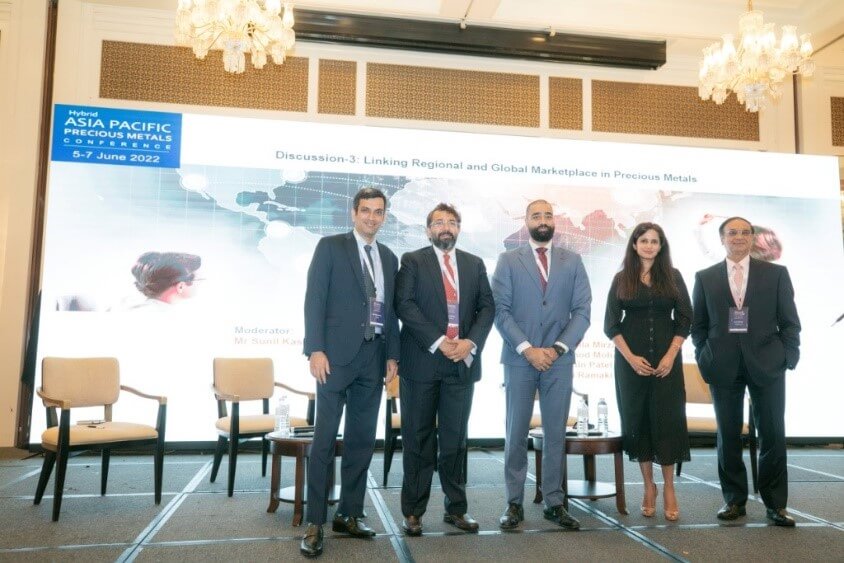
Starting Day 2, Ashok Gautam, managing director and CEO of India International Bullion Exchange (IIBX), gave details on the soon-to-be inaugurated exchange that, for the first time, will allow qualified jewellers to import gold against US dollars directly. This has been approved by the Reserve Bank of India. Other projects in the pipeline include gold loans, leased products to access US dollar liquidity and the introduction of gold and silver ETFs in India.
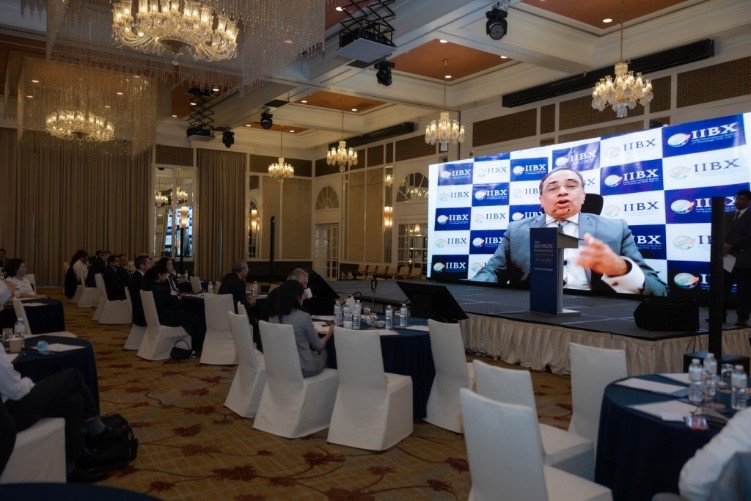
SBMA CEO Albert Cheng returned as a moderator, leading the roundtable discussion on China. Zhao Fanghua, general manager of the Shanghai Gold Exchange International (SGEI), gave an overview and update on gold trading volumes on the exchange. She also introduced the Gold Road project and talked about continued collaboration and opening up to increase international participation. Tracy Yan from the market and strategy department of SGEI then provided further details and statistics highlighting how large and critical the Chinese gold market is to the global gold market. She shared some insights on the Gold Road initiative, encouraging international entities to work with counterparts in China through the SGEI.
To illustrate the advantages of participating in this initiative, Mr Alan Liew, head of bullion and commodity trading, United Overseas Bank (UOB), and Huang Yourong, deputy general manager of the marketing department, Zijin Mining Group, provided more specific insights on their own experiences. Liew shared UOB’s experiences and helped the audience to understand why international entities might want to trade on the SGE. Huang then explained its set-up of participating onshore via the SGE and in the International, trading gold out of Hong Kong. He highlighted how the company’s participation in the Gold Road initiative helps facilitate gold exports, widen its overseas channels, and expand globally.
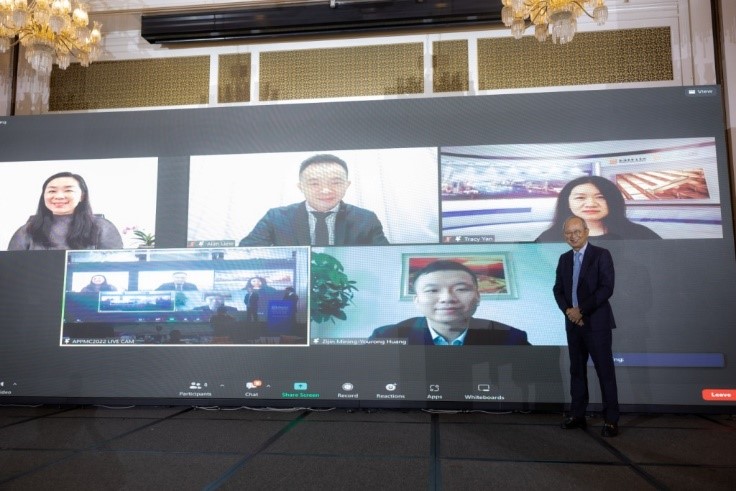
Paul Wilson, CEO of the World Platinum Investment Council (WPIC), who presented on platinum and PGMs, argued the case for platinum as an investment, highlighting some of its advantages against gold, including platinum being 30 times rarer than gold. However, the most compelling argument Wilson presented in platinum’s favour was that supply is likely to be constrained, while at the same time there is a decent potential for demand growth in the long run for platinum out of the hydrogen economy.
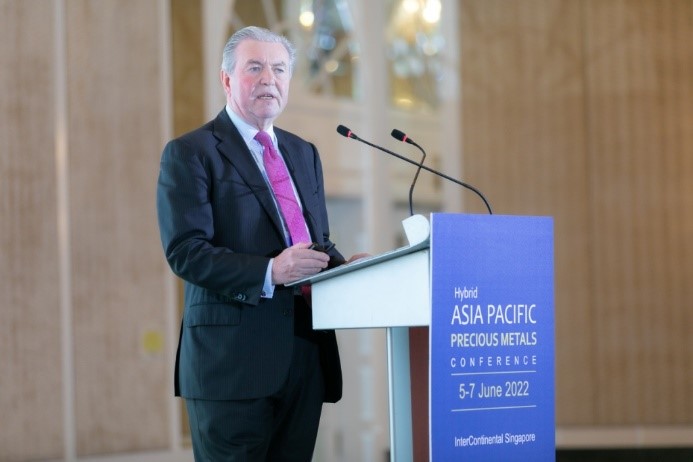
Gregor Gregersen, founder of Silver Bullion, introduced us to The Reserve, a modern design-forward building that will hold expensive things like gold, high-end watches, and art. It should be ready early to mid-2023, built next to Changi Airport.

Roland Wang, CEO of WGC China, gave an update on China’s gold market, highlighting the resilience of the market in Q1 but the likelihood of a weaker second quarter. He also detailed the WGC’s initiatives in China to promote awareness and support the gold jewellery industry.
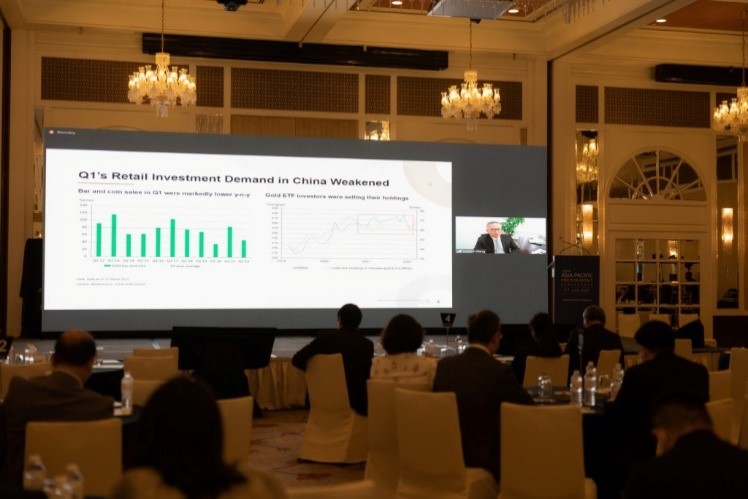
The fourth-panel discussion was on the digitisation of gold led by Matthew Keen, managing director of Emergent Technology & Responsible Gold Trading DMCC, joined by Gaurav Mathur, managing director of SafeGold, Brian Lan, co-founder of Goldblocx, Barry Ip, head of digital innovation, CGSE, Urs Roosli, CEO of aXedras Group AG and Simon Sywak, COO of Vaultex Exchange. Digitisation of gold seems to depend on the target market. Focusing upstream and when talking about institutional investors, the emphasis would be more on the provenance, ESG and having a trusted harmonised platform where one can get all of the data, which Roosli talked about. Downstream on the consumer end, the focus would be more on having a user-friendly setup, convenient transactions, access to affordable prices and divisibility. It also depends on the market. As stated clearly by Lan and Mathur, markets like India and China are more focused on physical delivery. Sywak also pointed out the distinction between primary issuers of these gold tokens or digital gold assets versus having a secondary market to trade.
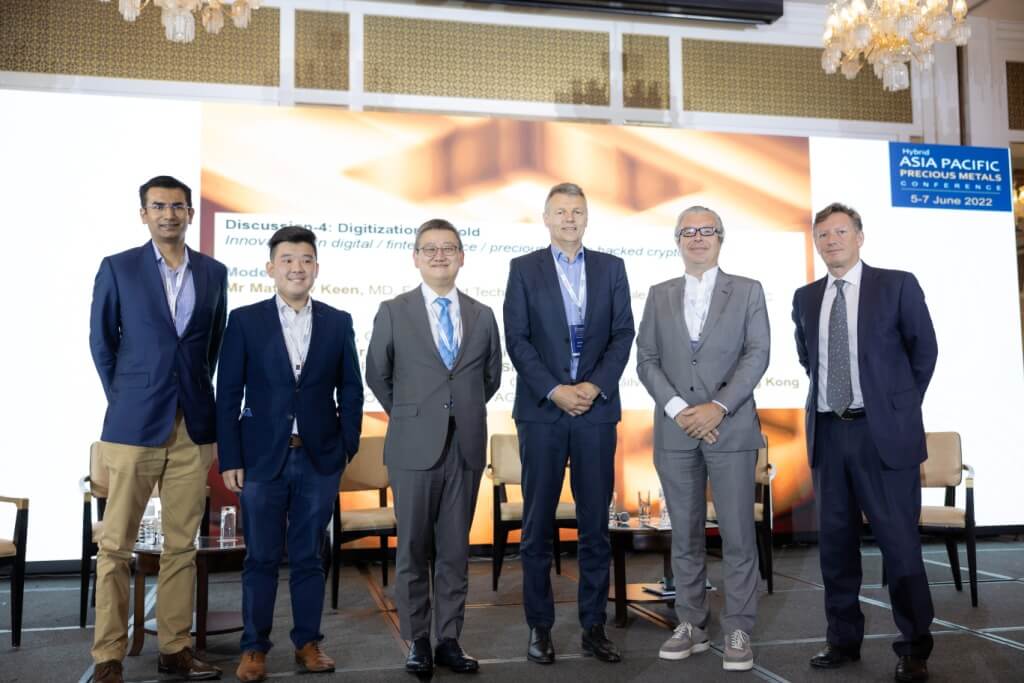
The fifth and final panel was packed with information and kicked off with the launch of the 2022 Gold Focus by Nikos Kavalis, managing director of Metals Focus and the presentation by Rhona O’Connell, head of market analysis EMEA & Asia at StoneX Group on the global platinum and palladium market trends. They were later joined by JBMA’s Ikemizu, Trevor Raymond, WPIC director of research, Cameron Alexander, manager of market development and industry research of the Perth Mint, and Silver Bullion’s Gregersen as panelists.
Towards the end of the conference, it was great to have different perspectives on the price outlook for the precious metals. Various aspects of the market were represented, including that of a refinery, bullion dealer, and investors. Gregersen and Ikemizu were most bullish, with a year-end target of US$1,950–2,000 for gold. Ikemizu and Raymond were bullish on platinum, with a year-end target of US$1,700. There was more consensus on silver, looking for US$26 by the end of the year, estimated by Gregersen and Ikemizu.
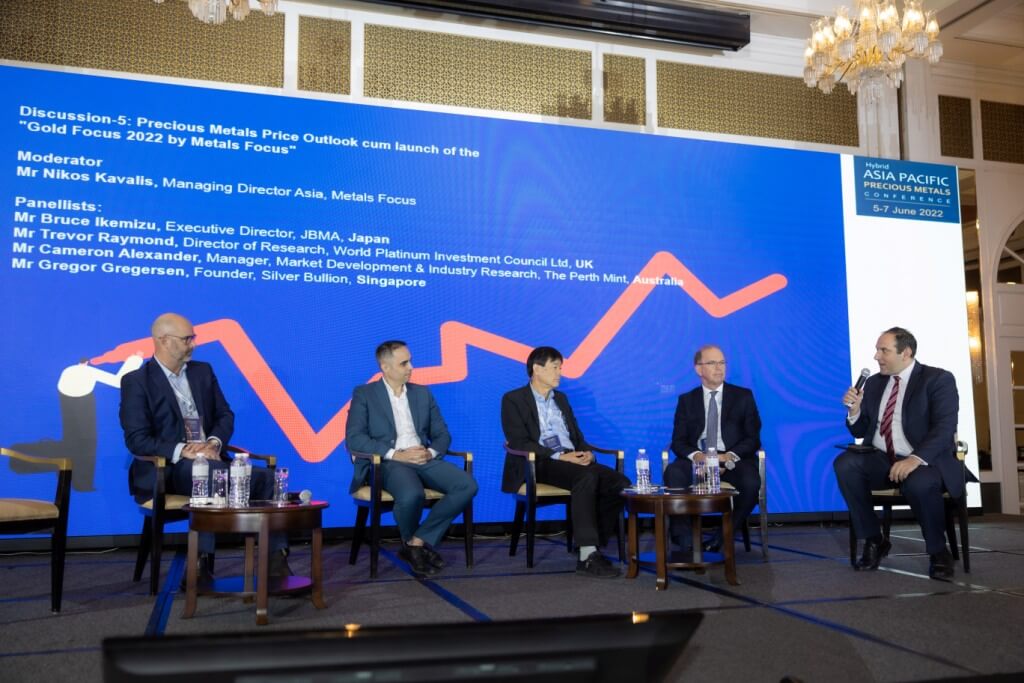
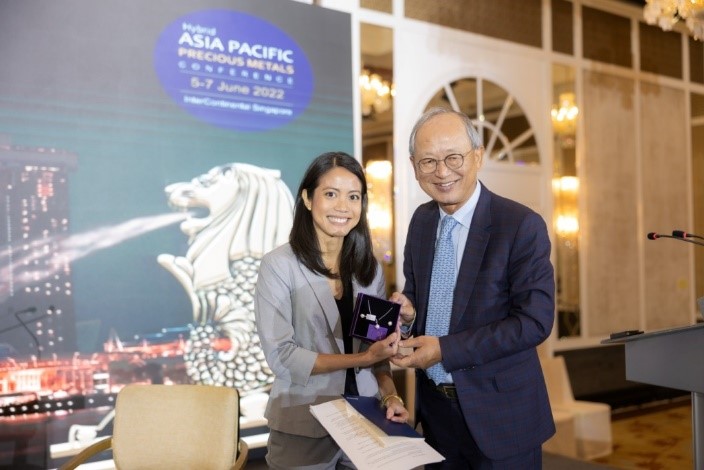

JONI TEVES is the precious metals strategist within the UBS Economics and Strategy Research team, based in Singapore. She covers all four precious metals and is responsible for fundamental analysis, forecasting, and writing research pieces on these markets. She has been in the industry for 16 years, initially as a gold trader for the central bank of the Philippines, subsequently joining UBS as a precious metals strategist in 2011.























